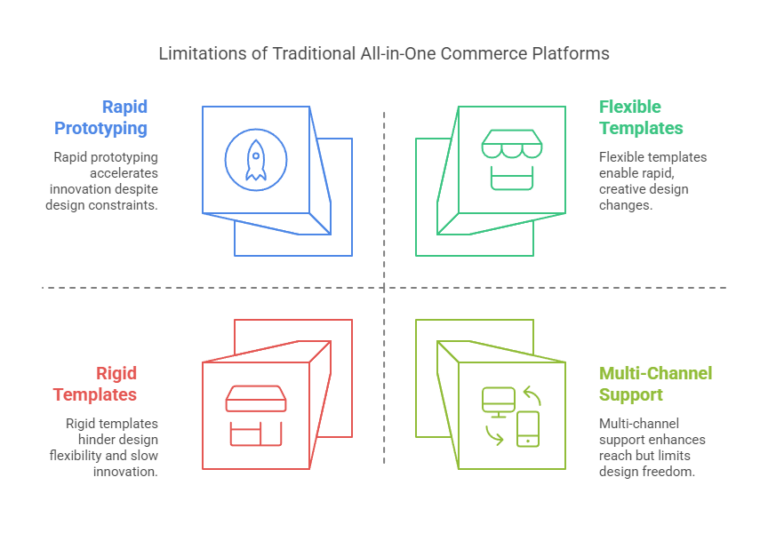Greetings! I'm Aneesh Sreedharan, CEO of 2Hats Logic Solutions. At 2Hats Logic Solutions, we are dedicated to providing technical expertise and resolving your concerns in the world of technology. Our blog page serves as a resource where we share insights and experiences, offering valuable perspectives on your queries.

Ever stared at your ecommerce website and thought, “This just isn’t flexible enough for what we need to accomplish”?
You’re not alone.
As traditional commerce platforms struggle to keep pace with evolving customer expectations, headless commerce has emerged as the solution modern brands are embracing.
At 2HatsLogic, we’ve implemented dozens of headless commerce solutions for companies ranging from ambitious startups to established enterprises.
This comprehensive analysis draws from our real-world implementation experience to help you navigate the complex landscape of headless commerce platforms in 2025.
What is Headless Commerce?
Headless commerce separates the front-end presentation layer (the “head”) from the back-end commerce functionality.
This architecture enables businesses to create highly customized shopping experiences across any customer touchpoint while maintaining a robust commerce engine behind the scenes.
Why Traditional Commerce Platforms Fall Short
Traditional all-in-one commerce platforms bind the front-end and back-end together, creating several limitations:
- Rigid templates that restrict design freedom
- Slower innovation cycles due to monolithic architecture
- Difficulty supporting multiple channels (web, mobile, IoT, etc.)
- Limited customization without significant development costs

Get our expert assessment of which headless platform aligns with your business goals.
The Business Case for Headless Commerce
Before diving into specific platforms, let’s understand why headless commerce has become essential for forward-thinking brands:
- Flexibility and agility – Deploy new experiences without disrupting core commerce functions
- Omnichannel capabilities – Deliver consistent experiences across web, mobile, IoT, AR/VR, and future touchpoints
- Improved performance – Optimize front-end experiences independently from back-end processes
- Future-proofing – Easily adopt new technologies as they emerge without rebuilding your entire commerce stack
Top Headless Commerce Platforms for 2025
Based on our extensive implementation experience at 2HatsLogic, here are the leading headless commerce platforms dominating the market in 2025:
1. Commercetools
Commercetools pioneered the headless commerce approach and continues to lead the market with its API-first, cloud-native platform.
Key Strengths:
- Comprehensive API-first approach
- Microservices architecture
- Robust marketplace of integrations
- Advanced personalization capabilities
- Enterprise-grade scalability
Best For: Large enterprises and mid-market companies with complex requirements and dedicated development resources.
Real-World Implementation: One of our clients, a multinational apparel retailer, migrated from a legacy platform to Commercetools and experienced a 43% improvement in page load speeds and a 28% increase in conversion rates within three months.
2. Elastic Path
Elastic Path offers a highly flexible headless commerce solution with strong B2B capabilities.
Key Strengths:
- Advanced catalog management
- Strong B2B functionality
- Subscription commerce capabilities
- Composable commerce approach
- Flexible deployment options
Best For: B2B companies and organizations with complex product catalogs or subscription models.
Real-World Implementation: We helped a manufacturing supplies distributor implement Elastic Path, enabling them to support complex B2B purchasing workflows while reducing their order processing costs by 32%.
3. BigCommerce
BigCommerce has evolved from a traditional platform to embrace headless commerce through their robust APIs and headless-specific features.
Key Strengths:
- Balance of ease-of-use and headless capabilities
- Extensive partner ecosystem
- Strong out-of-the-box features
- Competitive pricing
- Quick implementation timeline
Best For: Mid-market companies looking to adopt headless without the complexity of a fully custom solution.
Real-World Implementation: A home goods retailer we worked with launched a headless storefront using BigCommerce as the backend while maintaining their existing CMS, resulting in a 35% increase in mobile conversions.
4. Fabric
Fabric is a newer entrant that has gained significant traction with its modular commerce platform.
Key Strengths:
- Modular approach to commerce services
- Strong PIM capabilities
- Advanced pricing engine
- Experience management tools
- Developer-friendly documentation
Best For: Digital-first brands looking for a modern, modular approach without the legacy baggage of older platforms.
Real-World Implementation: We helped a direct-to-consumer beauty brand implement Fabric’s headless commerce platform, enabling them to launch 15 international storefronts in just 12 weeks.
5. Shopify Hydrogen & Oxygen
Shopify has embraced headless commerce with Hydrogen (their React-based framework) and Oxygen (their hosting platform).
Key Strengths:
- Familiar with the Shopify admin experience
- React-based development framework
- Performant hosting through Oxygen
- Access to Shopify’s vast app ecosystem
- Strong community support
Best For: Brands already on Shopify looking to extend their capabilities with a headless approach.
Real-World Implementation: A fashion retailer client maintained their Shopify backend while implementing a custom storefront with Hydrogen, achieving a 52% improvement in core web vitals and a 23% increase in average order value.
Comparative Analysis: Platform Capabilities
| Platform | API Approach | Pricing Model | Time to Market | Technical Complexity | Best Use Case |
|---|---|---|---|---|---|
| Commercetools | REST/GraphQL | Consumption-based | 3-6 months | High | Enterprise with complex requirements |
| Elastic Path | REST | Tiered licensing | 2-4 months | Medium-High | B2B with complex catalogs |
| BigCommerce | REST/GraphQL | Tiered subscription | 1-3 months | Medium | Mid-market multi-channel retail |
| Fabric | REST/GraphQL | Modular pricing | 2-3 months | Medium | Digital-first DTC brands |
| Shopify Hydrogen | GraphQL | Shopify Plus subscription | 1-2 months | Medium-Low | Shopify merchants seeking flexibility |
💡 Pro Tip: When evaluating headless commerce platforms, don’t just look at feature lists. Consider your team’s technical capabilities, your long-term digital roadmap, and the total cost of ownership, including ongoing development needs.
Key Evaluation Criteria for Selecting Your Headless Platform
1. API Capabilities and Documentation
The strength of a headless platform lies in its APIs. Evaluate:
- API completeness (do they cover all commerce functions?)
- Documentation quality
- Developer resources
- SDKs and client libraries
- Rate limits and performance
2. Ecosystem and Extensions
Even with a headless approach, you’ll need to integrate with other systems:
- Pre-built integrations
- Marketplace of extensions
- Partner network
- Authentication systems
- Payment gateways
3. Content Management Integration
Most headless implementations pair the commerce platform with a headless CMS:
- Existing integrations with popular CMSs
- Content modeling capabilities
- Asset management
- Workflow tools
- Preview capabilities
4. Performance and Scalability
Headless should deliver superior performance:
- Caching strategies
- Global CDN options
- Scaling capabilities
- High-traffic handling
- Infrastructure requirements
5. Total Cost of Ownership
Look beyond the platform subscription:
- Development costs (initial build)
- Ongoing maintenance
- Hosting requirements
- Integration costs
- Internal team capabilities
Uncertain about the technical requirements for headless implementation?
Implementation Challenges and How to Overcome Them
Challenge 1: Front-End Development Complexity
Headless commerce shifts more responsibility to the front-end development team.
Solution: Leverage modern frameworks like Next.js, Nuxt.js, or React that provide strong commerce capabilities. Consider front-end-as-a-service solutions for faster implementation.
Challenge 2: Preview Capabilities
Without the coupled nature of traditional platforms, preview functionality becomes more complex.
Solution: Implement a preview service that connects your commerce data with your front-end rendering. Many headless CMSs now offer this capability.
Challenge 3: Search Functionality
Search is often overlooked but critical for commerce success.
Solution: Implement a dedicated search service like Algolia, Elasticsearch, or Constructor.io rather than relying on basic platform search.
Challenge 4: Managing the Transition
Moving from a traditional to a headless architecture can be disruptive.
Solution: Consider a phased approach, starting with specific customer journeys or channels rather than a complete replatform.
💡 Pro Tip: Create a dedicated cross-functional team for your headless commerce implementation that includes both technical and business stakeholders. Success requires alignment between marketing, merchandising, IT, and leadership.
Future Trends in Headless Commerce for 2025-2026

As we implement headless solutions for our clients, we’re seeing several emerging trends:
1. Composable Commerce Acceleration
The market is moving beyond headless to fully composable approaches where each commerce function (cart, checkout, promotions, etc.) can be from different best-of-breed providers.
2. AI-Driven Personalization
Headless architectures are enabling more sophisticated AI-driven personalization by allowing flexible front-end experiences powered by powerful recommendation engines.
3. Edge Computing Integration
More headless implementations are leveraging edge computing to deliver ultra-fast experiences by performing rendering and personalization at the edge.
4. Expanded Commerce Channels
Headless is enabling commerce beyond websites and mobile apps into voice commerce, IoT devices, AR/VR experiences, and social commerce.
5. No-Code Front-End Tools
The emergence of no-code tools for headless front-ends is making the approach more accessible to brands without large development teams.
Case Study: How We Transformed a Retailer’s Digital Presence with Headless Commerce
One of our clients, a specialty homegoods retailer with 50+ physical locations, was struggling with an aging Magento implementation that couldn’t keep pace with their digital ambitions.
Challenges:
- Slow site performance (5+ second load times)
- Inability to rapidly launch new marketing campaigns
- Limited mobile experience
- High development costs for simple changes
- Disconnected in-store and online experiences
Our Approach:
- Implemented Commercetools as the commerce engine
- Added Contentful as the headless CMS
- Built a custom storefront using Next.js
- Deployed on Vercel for optimal performance
- Integrated with their existing ERP and POS systems
Results:
- 78% improvement in page load time
- 42% increase in mobile conversion rate
- 28% higher average order value
- 65% faster time-to-market for new features
- Seamless omnichannel capabilities between online and in-store
Making the Right Choice for Your Business
Selecting the right headless commerce platform requires careful consideration of your specific business needs:
For Enterprise Organizations:
Platforms like Commercetools and Elastic Path offer the robust architecture and flexibility needed for complex requirements, though they require significant development resources.
For Mid-Market Companies:
BigCommerce and Fabric provide a balance of capability and implementation speed, making them strong options for growing businesses.
For Digital-First Brands:
Shopify Hydrogen offers a developer-friendly approach while maintaining the familiar Shopify ecosystem, ideal for brands prioritizing speed and creative flexibility.
Conclusion: The Future is Headless
As customer expectations continue to evolve rapidly, headless commerce has moved from an innovative approach to a strategic necessity. The platforms we’ve covered represent the best options available in 2025, each with unique strengths and ideal use cases.
Remember that successful headless commerce implementation isn’t just about choosing the right platform – it’s about aligning your technology decisions with your business strategy and customer experience goals.
Ready to explore how headless commerce can transform your digital business? At 2HatsLogic, we specialize in helping companies evaluate, select, and implement the right headless commerce solutions for their unique needs.
Contact us today for a free consultation to discuss how we can help you navigate the headless commerce landscape and build a future-proof digital commerce strategy.
FAQ
What are the top headless commerce platforms in 2025?
The leading headless commerce platforms in 2025 include BigCommerce, Shopify Plus, Adobe Commerce (Magento), Elastic Path, and VTEX.
What benefits do headless commerce platforms provide?
Headless commerce platforms deliver faster performance, greater flexibility, improved developer productivity, and true omnichannel capabilities.
Are headless commerce platforms more expensive?
While headless commerce platforms often require higher initial investment in development resources, they typically deliver long-term cost efficiencies through improved performance, higher conversion rates, and reduced technical debt.
Table of contents
- What is Headless Commerce?
- Top Headless Commerce Platforms for 2025
- Comparative Analysis: Platform Capabilities
- Key Evaluation Criteria for Selecting Your Headless Platform
- Implementation Challenges and How to Overcome Them
- Future Trends in Headless Commerce for 2025-2026
- Conclusion: The Future is Headless

Related Articles






